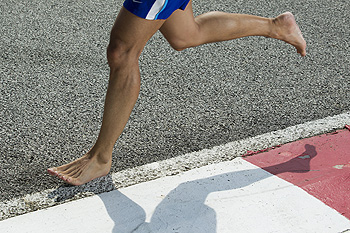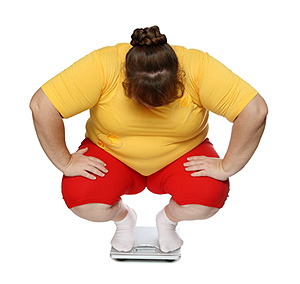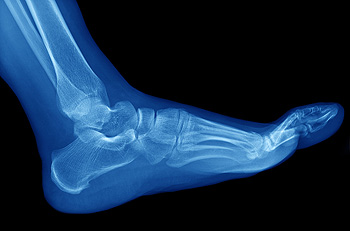Connect With Us
Blog
Items filtered by date: January 2018
Causes of Cracked Heels
 If you experience cracked heels, it may be the result of wearing non-supportive shoes such as flip-flops or open-back sandals. These types of shoes have little or no support at the back of the foot, often causing the heel to endure excessive strain. A hardened patch of skin, referred to as a callus, will often form to protect the heel against this added pressure. The skin on the heel may also begin to crack. A possible reason for cracked heels may be the extra pressure the heel must endure when standing on hard floors for long periods at a time. There are pre-existing medical conditions that should be considered as well, such as thyroid conditions, eczema, or diabetes. Several options are available to make your heels feel better, including using a moisturizer that softens the skin and soaking the feet in warm, soapy water. If you experience cracked heels that hinder your daily activities, please consider a consultation with a podiatrist for a proper assessment.
If you experience cracked heels, it may be the result of wearing non-supportive shoes such as flip-flops or open-back sandals. These types of shoes have little or no support at the back of the foot, often causing the heel to endure excessive strain. A hardened patch of skin, referred to as a callus, will often form to protect the heel against this added pressure. The skin on the heel may also begin to crack. A possible reason for cracked heels may be the extra pressure the heel must endure when standing on hard floors for long periods at a time. There are pre-existing medical conditions that should be considered as well, such as thyroid conditions, eczema, or diabetes. Several options are available to make your heels feel better, including using a moisturizer that softens the skin and soaking the feet in warm, soapy water. If you experience cracked heels that hinder your daily activities, please consider a consultation with a podiatrist for a proper assessment.
Cracked heels are unsightly and can cause further damage to your shoes and feet. If you have any concerns, contact Raul Hidalgo DPM from South Texas Foot & Ankle Care. Our doctor can provide the care you need to keep you pain-free and on your feet.
Cracked Heels
Cracked heels appear unappealing and can make it harder for you walk around in sandals. Aside from looking unpleasant, cracked heels can also tear stockings, socks, and wear out your shoes. There are several methods to help restore a cracked heel and prevent further damage.
How Do You Get Them?
Dry skin is the number one culprit in creating cracked heels. Many athletes, walkers, joggers, and even swimmers suffer from cracked heels. Age and skin oil production play a role to getting cracked heels as well.
Promote Healing
Over the counter medicines can help, especially for those that need instant relief or who suffer from chronic dry feet.
Wear Socks – Wearing socks with medicated creams helps lock in moisture.
Moisturizers – Applying both day and night will help alleviate dryness which causes cracking.
Pumice Stones – These exfoliate and remove dead skin, which allows for smoother moisturizer application and better absorption into the skin.
Change in Diet
Eating healthy with a well-balanced diet will give the skin a fresh and radiant look. Your body responds to the kinds of food you ingest. Omega-3 fatty acids and zinc supplements can also revitalize skin tissue.
Most importantly, seek professional help if unsure how to proceed in treating cracked heels. A podiatrist will help you with any questions or information needed.
If you have any questions, please feel free to contact our office located in San Antonio, TX . We offer the newest diagnostic and treatment technologies for all your foot care needs.
Reminder: When Was the Last Time...?
Treatment for Hammertoe
 One common cause of the condition known as hammertoe is wearing shoes that don’t fit correctly. When the toes are in a cramped position for an extended period of time, it’s natural for the muscles of the toes to become shorter, causing the toes to lock into a curved position. Patients who have arthritis or diabetes may be prone to developing hammertoe, and those who have a certain inherited gene may also be at risk. Occasionally the toes can be straightened, and in most cases, a splint may be utilized for stretching the toe. However, if the toe is completely locked up, surgery may be necessary. There are muscle strengthening exercises that aid in helping the foot to become stronger, possibly decreasing the discomfort originating from this condition. When the proper shoes are worn, which may make it necessary to increase the size of the shoe, more room is provided for the toes to feel comfortable. Often this is a condition that won’t disappear naturally, and a consultation is strongly advised for proper diagnosis and treatment.
One common cause of the condition known as hammertoe is wearing shoes that don’t fit correctly. When the toes are in a cramped position for an extended period of time, it’s natural for the muscles of the toes to become shorter, causing the toes to lock into a curved position. Patients who have arthritis or diabetes may be prone to developing hammertoe, and those who have a certain inherited gene may also be at risk. Occasionally the toes can be straightened, and in most cases, a splint may be utilized for stretching the toe. However, if the toe is completely locked up, surgery may be necessary. There are muscle strengthening exercises that aid in helping the foot to become stronger, possibly decreasing the discomfort originating from this condition. When the proper shoes are worn, which may make it necessary to increase the size of the shoe, more room is provided for the toes to feel comfortable. Often this is a condition that won’t disappear naturally, and a consultation is strongly advised for proper diagnosis and treatment.
Hammertoe
Hammertoes can be a painful condition to live with. For more information, contact Raul Hidalgo DPM from South Texas Foot & Ankle Care. Our doctor will answer any of your foot- and ankle-related questions.
Hammertoe is a foot deformity that affects the joints of the second, third, fourth, or fifth toes of your feet. It is a painful foot condition in which these toes curl and arch up, which can often lead to pain when wearing footwear.
Symptoms
- Pain in the affected toes
- Development of corns or calluses due to friction
- Inflammation
- Redness
- Contracture of the toes
Causes
Genetics – People who are genetically predisposed to hammertoe are often more susceptible
Arthritis – Because arthritis affects the joints in your toes, further deformities stemming from arthritis can occur
Trauma – Direct trauma to the toes could potentially lead to hammertoe
Ill-fitting shoes – Undue pressure on the front of the toes from ill-fitting shoes can potentially lead to the development of hammertoe
Treatment
Orthotics – Custom made inserts can be used to help relieve pressure placed on the toes and therefore relieve some of the pain associated with it
Medications – Oral medications such as anti-inflammatories or NSAIDs could be used to treat the pain and inflammation hammertoes causes. Injections of corticosteroids are also sometimes used
Surgery – In more severe cases where the hammertoes have become more rigid, foot surgery is a potential option
If you have any questions please contact our office located in San Antonio, TX . We offer the newest diagnostic and treatment technologies for all your foot and ankle needs.
Why Live with Pain and Numbness in Your Feet?
Techniques and Stretches for Preventing Running Injuries
 Relieving stress and shedding calories are a couple of popular reasons for running regularly, but occasionally it comes at cost of incurring an injury. To prevent these types of mishaps, it may be helpful to wear the correct shoes in addition to paying attention to any aches in the legs. If pain should develop in the knee, it usually happens because the cartilage becomes worn and irritated. When this occurs ice may be the best treatment; however, preventing it by performing proper exercises regularly will be beneficial as well. Shin splints are a common injury to develop and are typically felt when running first begins. The inflamed tendons commonly affected are found near the shin, and this type of injury may be prevented by stretching the calf muscles. Discomfort near the heel is most often associated with possible damage to the Achilles tendon, and focusing on low-impact exercises may temporarily relieve the pain. If symptoms are experienced from a possible running injury, a consultation with a podiatrist is advised for proper treatment techniques.
Relieving stress and shedding calories are a couple of popular reasons for running regularly, but occasionally it comes at cost of incurring an injury. To prevent these types of mishaps, it may be helpful to wear the correct shoes in addition to paying attention to any aches in the legs. If pain should develop in the knee, it usually happens because the cartilage becomes worn and irritated. When this occurs ice may be the best treatment; however, preventing it by performing proper exercises regularly will be beneficial as well. Shin splints are a common injury to develop and are typically felt when running first begins. The inflamed tendons commonly affected are found near the shin, and this type of injury may be prevented by stretching the calf muscles. Discomfort near the heel is most often associated with possible damage to the Achilles tendon, and focusing on low-impact exercises may temporarily relieve the pain. If symptoms are experienced from a possible running injury, a consultation with a podiatrist is advised for proper treatment techniques.
Exercising your feet regularly with the proper foot wear is a great way to prevent injuries. If you have any concerns about your feet, contact Raul Hidalgo DPM of South Texas Foot & Ankle Care. Our doctor will treat your foot and ankle needs.
How to Prevent Running Injuries
Many common running injuries are caused by overuse and overtraining. When the back of the kneecap starts wearing out and starts causing pain in your knee, this is commonly referred to as runner’s knee. Runner’s knee is a decrease in strength in your quadriceps and can occur if you’re not wearing properly fitted or supporting shoes. To prevent runner’s knee, focusing on hip strengthening is a good idea, as well as strengthening your quads to keep the kneecaps aligned.
What Are Some Causes of Running Injuries?
- One cause of a common running injury is called iliotibial band syndrome.
- Plantar fasciitis is also another common injury.
- Stress fractures can occur from overtraining, lack of calcium, or even your running style.
Best Ways to Prevent Running Injuries
- Wear footwear that fits properly and suits your running needs.
- Running shoes are the only protective gear that runners have to safeguard them from injury.
- Make a training schedule. Adding strengthening exercises as well as regular stretching can help keep you strong and limber and can lessen the possibility of injuries.
- Stretching keeps muscles limber; this will help you gain better flexibility.
If you have any questions please feel free to contact our office located in San Antonio, TX . We offer the newest diagnostic and treatment technologies for all your foot and ankle needs.
Do Your Child's Feet Hurt?
Can Being Obese Affect My Feet?
 Obesity is a worldwide issue, affecting people from many different countries, and is often seen as a gateway for serious health conditions. The extra weight may cause imbalanced walking, consequently putting people at risk for falls and ankle sprains or breaks. Some people experience swollen feet, often being a sign of circulatory problems, in addition to developing cracked heels, originating from additional pressure on the feet. Practicing proper foot hygiene is crucial for preventing many different kinds of foot disorders. Drying the skin between the toes is important, as this habit may prevent fungal infections from developing. Additionally, because some feet may be wider than average, it is critical to wear a well-fitted shoe. If you are experiencing health issues in your feet, a consultation with a podiatrist is advised for a diagnosis and treatment options.
Obesity is a worldwide issue, affecting people from many different countries, and is often seen as a gateway for serious health conditions. The extra weight may cause imbalanced walking, consequently putting people at risk for falls and ankle sprains or breaks. Some people experience swollen feet, often being a sign of circulatory problems, in addition to developing cracked heels, originating from additional pressure on the feet. Practicing proper foot hygiene is crucial for preventing many different kinds of foot disorders. Drying the skin between the toes is important, as this habit may prevent fungal infections from developing. Additionally, because some feet may be wider than average, it is critical to wear a well-fitted shoe. If you are experiencing health issues in your feet, a consultation with a podiatrist is advised for a diagnosis and treatment options.
Obesity has become very problematic at this point in time and can have extremely negative effects on the feet. If you’re an obese individual and are concerned about your feet, contact Raul Hidalgo DPM from South Texas Foot & Ankle Care. Our doctor can provide the care you need to keep you pain-free and on your feet.
Obesity and Your Feet
Since your feet are what support your entire weight when standing, any additional weight can result in pain and swelling. Being overweight is one of the main contributors to foot complications.
Problems & Complications
Extra Weight – Even putting on just a few extra pounds could create serious complications for your feet. As your weight increases, your balance and body will shift, creating new stresses on your feet. This uneven weight distribution can cause pain, even while doing the simplest tasks, such as walking.
Diabetes – People who are overweight are at serious risk of developing type-2 diabetes, which has a drastic impact on the health of your feet. As you get older, your diabetes might worsen, which could lead to loss of feeling in your feet, sores, and bruises. You could also become more prone to various infections.
Plantar fasciitis – Pressure and stress that is placed on muscles, joints, and tendons can trigger plantar fasciitis, which is an inflammation of tissue that forms along the bottom of the foot.
If you have any questions please feel free to contact our office located in San Antonio, TX . We offer the newest diagnostic and treatment technologies for all your foot and ankle needs.
How the Foot is Structured
The relationship between the foot and the lower leg in motion is called foot biomechanics. When the foot is structured correctly, routine activities such as walking and running should typically occur without pain. The foot and ankle combine flexibility with support, providing functions that include shock absorption of one's body weight. Additionally, this part of the body acts as a lever during the push-off period before taking a step. There are 26 bones located in the foot and ankle; these bones are maintained by ligaments and tendons, helping the arches “give” when weight is placed on the foot. Functions of the arches include supporting the weight of the body while standing. The structure of the foot is anatomically linked, resulting in even distribution throughout the foot during weight-bearing activities.
If you have any concerns about your feet, contact Raul Hidalgo DPM from South Texas Foot & Ankle Care. Our doctor can provide the care you need to keep you pain-free and on your feet.
Biomechanics in Podiatry
Podiatric biomechanics is a particular sector of specialty podiatry with licensed practitioners who are trained to diagnose and treat conditions affecting the foot, ankle and lower leg. Biomechanics deals with the forces that act against the body, causing an interference with the biological structures. It focuses on the movement of the ankle, the foot and the forces that interact with them.
A History of Biomechanics
- Biomechanics dates back to the BC era in Egypt where evidence of professional foot care has been recorded.
- In 1974, biomechanics gained a higher profile from the studies of Merton Root, who claimed that by changing or controlling the forces between the ankle and the foot, corrections or conditions could be implemented to gain strength and coordination in the area.
Modern technological improvements are based on past theories and therapeutic processes that provide a better understanding of podiatric concepts for biomechanics. Computers can provide accurate information about the forces and patterns of the feet and lower legs.
Understanding biomechanics of the feet can help improve and eliminate pain, stopping further stress to the foot.
If you have any questions please feel free to contact our office located in San Antonio, TX . We offer the newest diagnostic and treatment technologies for all your foot and ankle needs.
Blog Archives
- March 2025
- February 2025
- January 2025
- December 2024
- November 2024
- October 2024
- September 2024
- August 2024
- July 2024
- June 2024
- May 2024
- April 2024
- March 2024
- February 2024
- January 2024
- December 2023
- November 2023
- October 2023
- April 2022
- March 2022
- February 2022
- January 2022
- December 2021
- November 2021
- October 2021
- September 2021
- August 2021
- July 2021
- June 2021
- May 2021
- April 2021
- March 2021
- December 2018
- November 2018
- October 2018
- September 2018
- August 2018
- July 2018
- June 2018
- May 2018
- April 2018
- March 2018
- February 2018
- January 2018
- December 2017
- November 2017
- October 2017





